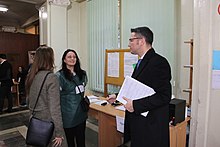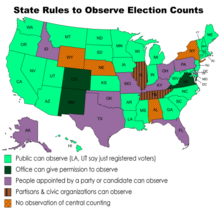Election monitoring
This article includes a list of general references, but it lacks sufficient corresponding inline citations. (March 2010) |


Election monitoring involves the observation of an
History
The first monitored election was that of an 1857
Organizations

International organizations such as the
International observation is complemented in many countries by domestic observer groups.
International election monitoring

Standard international election observation missions, as deployed by, for the example, the European Commission or the OSCE Office for Democratic Institutions and Human Rights (ODIHR), monitor the entire electoral process. Election experts and long-term observers begin their work weeks before the actual election day, looking at candidate registration, the legal framework, the media situation, the work of the election administration, and the campaign environment. On election day, short-term observers monitor the opening of polling stations, the vote cast, and the counting and tabulation of results. After election day, observers remain in the country for another few weeks to monitor how possible election-related shortcomings and complaints are dealt with by the election administration and the judiciary. The findings of the observers are made public in reports issued after election day.
Long-term observers
Most observation missions send a small number of long-term monitors (known as LTOs) for a period of six to eight weeks. A larger number of short-term observers (known as STOs) then join the mission for the final week of the campaign. STOs provide mostly quantitative observation of polling station and count procedures, with LTOs supplying qualitative analysis and contextual information about the wider political situation.[citation needed]
In some cases, the objectivity of some international observers is questioned.[6]
Domestic election monitoring

In addition to international organizations monitoring elections, citizen organizations—or coalitions of organizations—also monitor elections in their own country.
The most common type of domestic election monitoring comes by way of party
There are, however, also numerous domestic nonpartisan observer groups in many countries.
Free and Fair Election Network (FAFEN) in Pakistan is a coalition of 42 national civil society organizations working together to promote fair elections in Pakistan.
Each jurisdiction may have different rules about who may observe. Rules vary by state in the United States.[7]
Local and regional election monitoring
Most international observer organizations have a mandate to observe parliamentary elections and some organizations, such as the
The Congress Strategy on election observation is based on three lines of action:
- Election monitoring by the Congress should contribute to setting up institutional frameworks which comply with the principles underlying local democracy as laid down in the European Charter of Local Self-Government. In light of this, the Congress puts the accent on post-election dialogue as part of the Congress' work on monitoring of local and regional democracy. The aim is to improve the follow-up given to the recommendations adopted by the Congress following election observation missions and to facilitate their implementation.
- Election monitoring by the Congress should contribute to promoting awareness about the significance of democracy at the local and regional level.
- Making full use of the unique role of the Congress in the field of election observation, efforts are also made to increase the operational capability of election observation missions.
See also
- CIS-EMO
- Organization for Security and Co-operation in Europe (OSCE)
- Eurasian Observatory for Democracy and Elections
- Congress of the Council of Europe
- National Democratic Institute for International Affairs
- International Republican Institute
- Uchaguzi
- Scrutineer
References
- S2CID 202327588.
- ^ ISSN 1094-2939.
- ^ "Declaration of Principles for International Election Observation" (PDF).
- ^ "Declaration of Global Principles for Nonpartisan Election Observation and Monitoring by Citizen Organizations" (PDF).[dead link]
- ^ The Carter Center list of elections observed. The Carter Center.
- ^ 'People power' is a global brand owned by America. By Mark Almond. August 15, 2006. The Guardian.
- ^ "Policies for Election Observers". National Conference of State Legislatures. Retrieved 2023-09-16.
- ^ Organization for Security and Co-operation in Europe (OSCE), "Election Observation Handbook: Sixth Edition," OSCE Office for Democratic Institutions and Human Rights (ODIHR) (2010).
- ^ The Congress of Local and Regional Authorities, "Resolution 274: Congress policy in observing local and regional elections," Council of Europe (2008).
Sources
- e-voting.cc: Observing Threats to Voter’s Anonymity: Election Observation of Electronic Voting
- Congress of the Council of Europe
- EU: Handbook for European Union Election Observation Missions
- OSCE: Election Observation Handbook
- OSCE: Handbook for Long Term Election Observers
- UN: Declaration of Principles for International Election Observation
- Guidelines on an internationally recognised status of election observers Venice Commission, 2009
External links
- Beyond intractability: Election monitoring
- IFES – Democracy at large: Election services
- National Democratic Institute for International Affairs: Elections and political processes
- The Global Network for Domestic Election Monitors
- OSCE Office for Democratic Institutions and Human Rights: Elections
- The Carter Center Democracy Program
- Commonwealth Observer Groups
